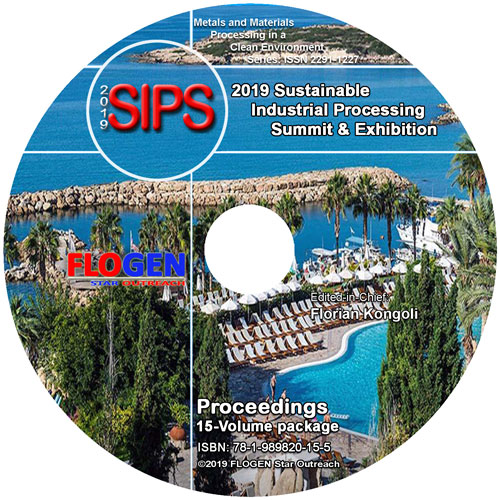2019-Sustainable Industrial Processing Summit
SIPS2019 Volume 8: Usui Intl. Symp. / Advanced Sustainable Iron and Steel Making
| Editors: | F. Kongoli, P. Assis, M.C. Gomez-Marroquin, S. Kitayama, H. Konishi, A. Murao, S. Nomura, H. Ono, H. Saxen, K. Seto, J.I. Tani |
| Publisher: | Flogen Star OUTREACH |
| Publication Year: | 2019 |
| Pages: | 250 pages |
| ISBN: | 978-1-989820-07-0 |
| ISSN: | 2291-1227 (Metals and Materials Processing in a Clean Environment Series) |

CD shopping page
THE BAKING ACID TECHNIQUE ALTERNATIVE TO DECREASE THE PHOSPHORUS CONTENT OF THE IRON ORE
Jose Adilson de Castro1; Leonardo Martins da Silva2; Marcos de Campos1; Elizabeth Oliveira3; RAYLA DE SOUZA CALDAS4;1UFF - FEDERAL FLUMINENSE UNIVERSITY, Volta Redonda, Brazil; 2UNIVERSIDADE FEDERAL FLUMINENSE, Volta Redonda, Brazil; 3CENTER FOR TECHNOLOGICAL EDUCATION CELSO SUCKOW DA FONSECA, Valenca, Brazil; 4UFF-PROGRAMA DE POS GRADUAçãO EM ENGENHARIA METALURGICA, Volta Redonda, Brazil;
Type of Paper: Regular
Id Paper: 201
Topic: 2
Abstract:
Unlike the available mineral resources, the steel-making processes require raw material with lower phosphorous content in order to decrease the costs, energy use and the residue generated within the steel plant. One alternative is to develop pre-treatment of the iron ore concentrates, achieving raw materials with lower phosphorous. Depending on the mineral structure, a heat treatment combined with leaching can be an efficient way to achieve concentrates with low phosphorous (less than 0.01%). A fast and efficient way of applying energy to iron ore particles is the use of microwave energy to heat the particles. Thus, we propose a treatment using microwave heating while admixing low concentration sulfuric acid, followed by quenching during leaching with water as a feasible route for phosphorus removal from iron ore particles. We performed a design of experiment (DOE) to investigate the optimal conditions of heating and leaching which maximize the rate of phosphorous removal. The structure of the iron ore particles after their treatment with microwave energy was observed using scanning electron microscopy (SEM). Disclosing results must be presented here: the optimal conditions for heating and leaching, how the structure of the iron ore particles is affected and which is the mechanism to which it corresponds, as well as the equations and the controlling mechanism.
We demonstrated that, under the most favorable combination of heating and leaching conditions proposed in this study, the reduction of the phosphorus content in the iron ore sample could reach 100%.